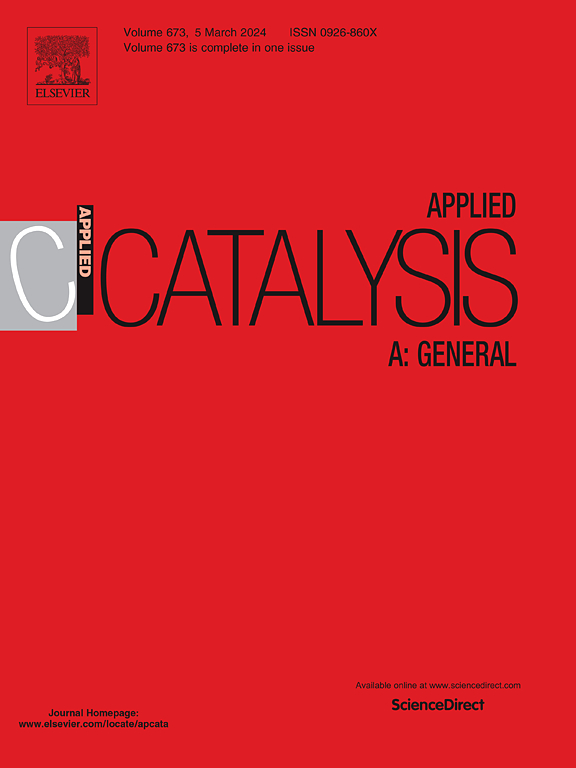极好的三维多孔结构金属泡沫支撑Ni/Ce/Al-CF系综作为甲醇分解制氢的活性结构催化剂
IF 4.7
2区 化学
Q2 CHEMISTRY, PHYSICAL
引用次数: 0
摘要
采用改性湿法化学蚀刻(MWCE)法制备了单金属Ni- cf、双金属Ni/Ce- cf、Ni/Al-CF和三金属Ni/Ce/Al-CF等金属泡沫负载Ni基催化剂,并在200 ~ 325℃的温度范围内用于甲醇分解制氢。其中,2Ni/3Ce/3Al-Cu泡沫(CF)催化剂表现出优异的制氢性能,在300℃时甲醇转化率几乎完全(99.3 %),H2选择性高达91.8 %。此外,在275℃的稳定性测试中,2Ni/3Ce/3Al-CF催化剂的性能在长达40 h的时间内保持稳定。SEM和BET表征表明,蚀刻泡沫铜可以显著扩大结构催化剂的比表面积,提供更多的活性位点,提高其催化活性。XPS证实,Ni、Ce和Al之间的强相互作用通过在三金属体系中产生丰富的氧空位而诱导了协同效应。H2-TPR和XPS进一步揭示了还原性和金属-载体相互作用之间的关键平衡:含Al的催化剂如2Ni/3Ce/3Al-CF表现出更高的还原阈值,并证实了Al通过强金属-载体相互作用稳定氧化镍的作用。CH3OH-TPD分析表明,由于三种金属的协同作用,该催化剂的低温产氢率明显高于其他催化剂,与催化剂活性测试结果一致。开发的策略可以为通过甲醇分解制氢的高性能结构催化剂的设计原则的发展提供见解。本文章由计算机程序翻译,如有差异,请以英文原文为准。
Superb three-dimensional porous-structured metal foam-supported Ni/Ce/Al-CF ensemble as an active structured catalyst for hydrogen production via methanol decomposition
A series of metal foam-supported Ni-based catalysts-monometallic Ni-CF, bimetallic Ni/Ce-CF, Ni/Al-CF and trimetallic Ni/Ce/Al-CF-were prepared by modified wet chemical etching (MWCE) and employed for hydrogen production via methanol decomposition (MD) in the temperature range of 200–325 ℃. Among those catalysts, the 2Ni/3Ce/3Al-Cu foam (CF) catalyst shows the superior catalytic performance for hydrogen production, achieving a remarkable activity of almost complete methanol conversion (99.3 %) and high H2 selectivity of 91.8 % at 300 ℃. Moreover, the performance of 2Ni/3Ce/3Al-CF catalyst remained stable during the stability test for up to 40 h at 275 ℃. SEM and BET characterization show that etched copper foam can remarkably enlarge the specific surface area of the structured catalyst, provide more active sites, and enhance its catalytic activity. The strong interaction among Ni, Ce and Al induce the synergistic effect by creating abundant oxygen vacancies in the trimetallic system as evidenced by XPS. H2-TPR and XPS further revealed a crucial balance between reducibility and metal-support interactions: Al-containing catalysts like 2Ni/3Ce/3Al-CF exhibit higher reduction thresholds and confirming the role of Al in stabilizing oxidized Ni species via strong metal-support interactions. And CH3OH-TPD analysis indicated the catalyst had much higher low-temperature hydrogen production than other catalysts because of the synergistic effect of three metals, consistent with the catalyst activity test results. The developed strategy may provide insights into the development of the design principles for high-performance structured catalysts for hydrogen production via methanol decomposition.
求助全文
通过发布文献求助,成功后即可免费获取论文全文。
去求助
来源期刊

Applied Catalysis A: General
化学-环境科学
CiteScore
9.00
自引率
5.50%
发文量
415
审稿时长
24 days
期刊介绍:
Applied Catalysis A: General publishes original papers on all aspects of catalysis of basic and practical interest to chemical scientists in both industrial and academic fields, with an emphasis onnew understanding of catalysts and catalytic reactions, new catalytic materials, new techniques, and new processes, especially those that have potential practical implications.
Papers that report results of a thorough study or optimization of systems or processes that are well understood, widely studied, or minor variations of known ones are discouraged. Authors should include statements in a separate section "Justification for Publication" of how the manuscript fits the scope of the journal in the cover letter to the editors. Submissions without such justification will be rejected without review.
 求助内容:
求助内容: 应助结果提醒方式:
应助结果提醒方式:


